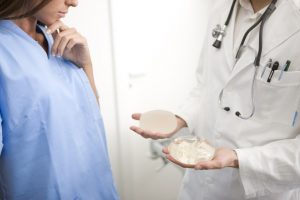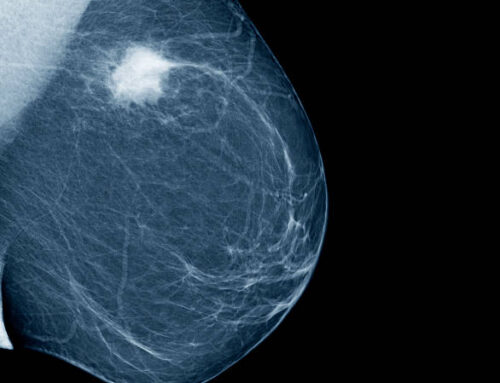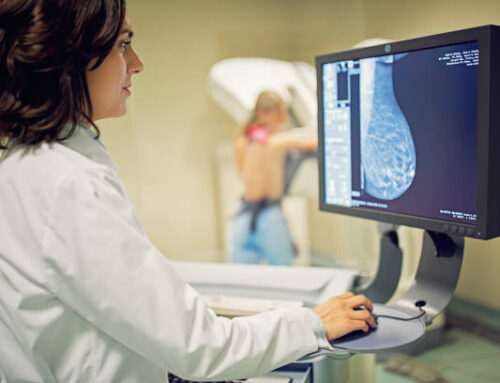Do you have breast implants and worry they will prevent you from getting an accurate mammogram? Have you avoided mammography completely since receiving implants because you’re afraid they will rupture during an exam? If so, rest assured that even though breast implants do add some challenges to mammography, trained doctors and technicians have the expertise to conduct a thorough, accurate mammogram on women who’ve undergone breast augmentation.
If you have breast implants, you should still get regular screening mammograms as recommended (unless you had both breasts removed with a bilateral mastectomy before getting the implants).
It’s important to tell the technologist you have implants before your mammogram is started. In fact, it’s best to mention this when you make the appointment to have your mammogram done. This way you can find out if the facility has experience doing mammograms in women with breast implants.
You should be aware that both silicone and saline implants can make it hard for the doctor to see the breast tissue that is in line with them on the mammogram.
To help the doctor see as much breast tissue as possible, women with implants have 4 extra pictures done (2 on each breast), as well as the 4 standard pictures taken during a screening mammogram. In these extra pictures, called implant displacement (ID) views, the implant is pushed back against the chest wall and the breast is pulled forward over it and then compressed. This allows better imaging of the front part of each breast so the doctor can get a better look at the breast tissue.
Implant displacement views are harder to do and can be uncomfortable if areas of scar tissue (called contractures) have formed around the implants. ID views are easier if the implants were placed underneath (behind) the chest muscles.
Very rarely, the mammogram process can rupture an implant. This is another important reason to make sure the mammography facility knows you have implants.

How Do Breast Implants Affect Mammography?
As a woman with breast implants, it’s important to know that implants do hinder getting a complete view of breast tissue during mammography. However, where the implants are placed makes a big difference. Implants that are placed under the chest muscles are much less likely to interfere with a mammogram than those placed above the chest muscles.
Breast implants contain silicone or gel that shows up as a white, opaque mass on a mammogram. Various studies show that between 15 to over 50 percent of breast tissue is obscured by implants. Additionally, placement of the implants can change how natural breast tissue is situated. The implant can press down or displace natural tissue, making it harder for doctors to notice calcifications, distorted tissue, and dense, small tumors. Further, scarring near the implants causes the buildup of harmless calcifications that mimic the look of cancer masses.
Should I Get a Mammogram if I Have Breast Implants?
Yes. Even though breast implants cause some challenges in mammography, getting a scan is your best chance for detecting early stage breast cancer. Seventy-five percent of women who are diagnosed with breast cancer have no family history or other risk factors. Since mammograms became the standard in the early 1990s, the death rate for women with breast cancer has plummeted by 33 percent.
Since millions of women have breast implants and doctors are trained to adapt their testing for it, it is possible to get accurate mammography results. First, the technician will take four scans of each breast instead of the standard two. Second, one of the scans will include a view of the implant pushed against the chest wall while the natural breast is pulled forward for optimal imaging. This scan can improve the accuracy of the mammogram by up to 92 percent.
Do Breast Implants Increase My Chance of Getting Cancer?
Not at all. In fact, various studies have shown that women with breast implants actually have a lower rate of breast cancer than the general population.
While there are unproven theories about why the incidence of breast cancer is lower for women with implants, the prevailing wisdom is that the implants themselves are not the reason. It is possible that women with implants have a reduced cancer risk because most tend to be thin (obese women are at much greater risk) and are from a higher socioeconomic group with greater access to good nutrition, exercise, and preventative health screenings.
Clearing up myths about breast implants and mammograms

Doctors often hear from women who mistakenly believe that breast implants and mammograms don’t mix. The truth is having breast implants should not prevent you from being able to get a mammogram or breast cancer screening.
There is one downside to having breast implants when it comes to breast imaging. The X-rays used in mammograms cannot go through silicone or saline implants well enough to see the area of breast tissue covered by the implant. But this isn’t a reason to skip mammograms.
In a regular screening mammogram, X-ray pictures of each breast are taken, typically from two different angles. If you have implants, a few more X-rays are taken. This is why it’s important to seek out a breast care center or an expert who has a lot of experience doing a mammogram with breast implants present.
“Skilled mammography technicians work daily with women who have breast implants and are experts at getting the best X-ray views for radiologists to examine,” says Scripps Clinic radiation oncologist Ray Lin, MD, with Scripps MD Anderson Cancer Center. “That means more peace of mind for you and less chances of you needing to redo a mammogram.”
Myths and facts about mammograms and breast implants
Knowledge is an important, powerful tool in protecting your health. For a successful mammogram, it’s important to let your technician know if you have implants before scheduling an appointment.
Here are the facts on some common misconceptions about mammograms and breast implants:
Myth: Implants cover up breast tissue so there’s no point in getting a mammogram.
Fact: Mammography technicians know exactly what to do to get X-rays that show as much breast tissue as possible. They will gently push the implant back against your chest wall and pull your breast tissue forward and over it. These extra X-ray pictures are called implant displacement views and capture better images of the front part of each breast.
Myth: Women with breast implants get too much radiation exposure during mammograms.
Fact: Today’s mammography machines use low radiation doses to take X-rays. If you have breast implants, you will need those extra X-ray pictures, but this should not pose any danger to you. “Radiation exposure goes up but just slightly. You will still be well within safe limits,” Dr. Lin says.
Studies show that the low levels of radiation from mammograms do not significantly increase your risk of cancer. “It’s far more dangerous to skip the mammogram and have undetected cancer,” Dr. Lin adds.
Myth: Implants can rupture during a mammogram screening.
Fact: It’s rare to experience a rupture during a screening. The chances are even lower when you choose a facility that routinely screens women with implants.
Myth: Women who get implants after mastectomies don’t need mammograms.
Fact: It depends on the type of mastectomy. If both breasts have been removed, then there is no breast tissue to scan. You can skip mammograms. Some women still need screenings. These include women who have undergone:
- Unilateral mastectomy, where there is one remaining breast to screen.
- Nipple-sparing mastectomy, where the nipples and a small amount of breast tissue need to be screened.
Myth: Women who have breast implants can’t get 3D mammogram screenings.
Fact: They can but if you’re concerned about increased radiation, you should talk to your doctor about the pros and cons of 3D mammography if you have implants.
Three-dimensional (3D) mammography, or breast tomosynthesis, is an advanced type of mammography. It involves taking pictures of thin layers of your breast from different angles to form a 3D image of your breast. These views make it easier to spot abnormalities.
The reason some doctors don’t recommend 3D mammograms for women with breast implants is that X-ray machines use a slightly higher dose of radiation, and you’re already receiving extra radiation exposure due to additional implant displacement pictures.
Stop by today for your mammogram or call us at (416) 759-3462 to make an appointment.




